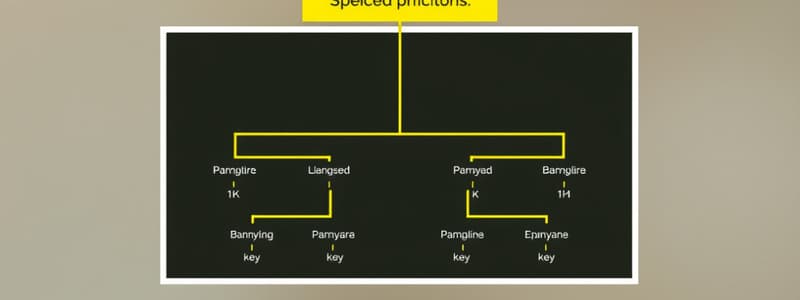Podcast
Questions and Answers
What is the definition of the term species?
What is the definition of the term species?
A species is defined as a group of organisms capable of passing genetic information within the group because the organisms can reproduce with one another.
How are organisms grouped into species?
How are organisms grouped into species?
Organisms are grouped into species based on similar physical characteristics and their ability to reproduce.
All organisms can be classified.
All organisms can be classified.
True (A)
How are organisms classified?
How are organisms classified?
How is a dichotomous key used to classify organisms?
How is a dichotomous key used to classify organisms?
How do scientific names differ from common names?
How do scientific names differ from common names?
How do scientists create scientific names?
How do scientists create scientific names?
What does an organism's scientific name tell us about the organism?
What does an organism's scientific name tell us about the organism?
How do scientists classify organisms?
How do scientists classify organisms?
What are some common features scientists use to classify organisms?
What are some common features scientists use to classify organisms?
What is the Linnaean system of classification?
What is the Linnaean system of classification?
Study Notes
Definition of Species
- A species consists of organisms capable of interbreeding and passing genetic information.
Grouping Organisms into Species
- Organisms are classified as a species based on shared physical characteristics and reproductive capabilities.
- Offspring produced by species can also reproduce, maintaining continuity within the group.
Classification of Organisms
- Every type of organism, including extinct ones, can be classified.
Basis of Classification
- Classification relies on physical traits; organisms may have backbones or be single-celled versus multi-celled.
- Uses an established hierarchy: Domain, Kingdom, Phylum, Class, Order, Family, Genus, and Species.
Dichotomous Key Usage
- A dichotomous key classifies organisms through a series of characteristic statements.
- Users select between two choices leading to further statements until an organism is identified.
Scientific vs. Common Names
- Common names are numerous and can refer to different organisms, whereas each species has a unique scientific name.
Creation of Scientific Names
- Scientific names comprise two parts: genus and species.
- Typically derived from Latin or Greek terms describing the organism's traits or characteristics.
Significance of Scientific Names
- A scientific name reveals the genus and species, providing insights into related organisms and evolutionary history.
- Translatable Latin or Greek names can indicate physical appearance, habitat, diet, and behavior.
Classification Criteria
- Scientists classify organisms based on shared physical features, such as respiratory systems or skeletal structures.
- Behavioral traits, including reproductive methods, are also considered in classification.
Linnaean System of Classification
- Organisms are categorized by shared characteristics in a hierarchical system: kingdom (largest) down to species (smallest).
- Each taxonomic group serves to arrange living things according to their similarities and differences.
Studying That Suits You
Use AI to generate personalized quizzes and flashcards to suit your learning preferences.
Description
Explore the intricacies of species definition and classification in this quiz. Learn about reproductive capabilities, physical characteristics, and the systematic hierarchy used to categorize organisms. Test your understanding of dichotomous keys and the differences between scientific and common names.




